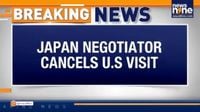Japan’s top trade negotiator, Ryosei Akazawa, abruptly canceled his planned trip to Washington on August 28, 2025, a move that has thrown a wrench into the finalization of a $550 billion investment package and deepened uncertainty over the future of U.S.-Japan trade relations. The visit was supposed to mark the tenth round of high-stakes talks aimed at cementing a joint statement on tariffs—a deal that both sides had publicly committed to just weeks earlier.
The cancellation, confirmed by Chief Cabinet Secretary Yoshimasa Hayashi, was prompted by unresolved administrative details that surfaced during last-minute discussions with U.S. officials. According to Reuters, Hayashi told reporters, “points that need to be discussed at the administrative level” had emerged, making the trip impossible to proceed as planned. This abrupt halt comes at a crucial juncture, as the two countries had reached a preliminary agreement in July to lower tariffs on most Japanese goods to 15% from a previously announced 25% by President Donald Trump. The lower tariffs were set to take effect on August 1, 2025.
But as often happens in international negotiations, the devil was in the details. Japanese officials discovered that the preliminary deal would actually add a 15% tariff on top of existing duties—a move they strongly objected to. The U.S. side, according to multiple news outlets including the Associated Press, acknowledged this mistake and agreed to abide by the true spirit of the agreement: a single 15% tariff, not a compounded rate. Washington also promised to refund any excess import duties that had already been paid. Yet, as of August 28, no such refunds had materialized, and the necessary amendments to the U.S. presidential order remained pending.
“We will strongly request the United States to amend its presidential order to correct the reciprocal tariffs and to issue the presidential order to lower tariffs on autos and auto parts,” Hayashi emphasized to the press. The sense of urgency from Tokyo was palpable, with Hayashi adding that “Japan and the United States have confirmed the importance of sincere and prompt implementation of the agreement between the two countries.” He also underscored that the deal is essential for the economic security of both nations.
The investment package at the center of the talks is no small matter. As part of the July agreement, Japan pledged to invest up to $550 billion in the United States over the coming years, a figure President Trump has touted as a sign of strengthening economic partnership. However, as reported by Reuters and NewsBytes, Japanese officials have clarified that much of this sum will come in the form of government-backed loans and guarantees, not direct cash infusions. Tokyo has also made it clear that these investments will be guided by Japanese interests and benefits, pushing back on Trump’s characterization of the funds as “our money to invest.”
The specifics of how investment returns would be shared between the two countries remain unclear. The planned Akazawa visit was expected to produce a written agreement on these terms, but with the trip on ice, both sides are left in limbo. U.S. Commerce Secretary Howard Lutnick, in an interview with Fox News earlier in the week, maintained that Washington was “ready to finalize the deal.” Still, the lack of concrete progress has left Japanese officials frustrated and wary.
Adding another layer of complexity, the trade standoff coincided with Indian Prime Minister Narendra Modi’s arrival in Japan for the 15th India-Japan Annual Summit with Prime Minister Shigeru Ishiba. Modi’s visit, his eighth to Japan and first formal meeting with Ishiba since the latter took office, is set to focus on deepening the “Special Strategic and Global Partnership” between the two nations. The summit agenda covers defense, trade, technology, and regional security, with both leaders expected to launch new initiatives. According to India’s Ministry of External Affairs, the summit will reaffirm the “longstanding friendship between the two nations while addressing regional and global challenges.”
Meanwhile, the delay in finalizing the U.S.-Japan deal has economic consequences. Japan’s exports to the U.S. saw their sharpest monthly fall in four years this July, a direct result of the tariff standoff. As a result, Tokyo has trimmed its growth forecast for the year from 1.2% to 0.7%. The pain is particularly acute for Japan’s auto sector, which has long been a target of U.S. trade policy. The July agreement included a commitment from Washington to lower tariffs on Japanese cars from 27.5% to 15%, but as NewsBytes and other outlets report, no timeline has been given for this crucial move.
In a bid to sweeten the deal for Washington, Japan has agreed to begin importing Ford’s large F-150 pickup trucks and to ease restrictions on American cars, including accepting U.S. vehicle safety standards. These measures are designed to address longstanding U.S. complaints about market access in Japan, but they have not been enough to break the current deadlock.
The broader geopolitical context can’t be ignored. Tariff tensions between Washington and Tokyo have also had ripple effects within the so-called Quad alliance—comprising the U.S., Japan, India, and Australia—especially as the U.S. has imposed hefty duties on Indian goods as well. Modi’s upcoming trip to China for the Shanghai Cooperation Organisation Summit, where he will meet with President Xi Jinping, underscores the shifting alliances and strategic calculations in the region.
Despite the current setback, there is still hope that talks can resume soon. Hayashi suggested that Akazawa could travel to Washington next week if the outstanding issues are resolved. For now, though, both sides remain at an impasse, with billions of dollars—and the stability of one of the world’s most important economic relationships—hanging in the balance.
As the world watches, it’s clear that the outcome of these negotiations will reverberate far beyond Tokyo and Washington. With economic growth, jobs, and the future of international trade rules at stake, the pressure is on for both countries to find common ground and move forward—before the window for compromise closes even further.


